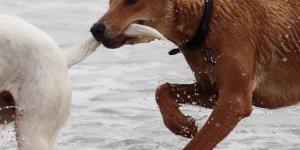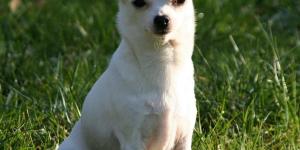Pembroke Welsh Corgi

The Pembroke Welsh Corgi is one of the most popular dog breeds in the world. Their adorable appearance and the fact that they are Queen Elizabeth II's favorite dogs have turned these hard-working herding dogs into canine royalty. Although their cute looks may make you believe they are easy-going family dogs, in fact Pembroke Welsh Corgis have a peculiar temperament that makes them suitable for experienced owners.
Stay with us at AnimalWised and learn all about the Pembroke Welsh Corgi: we'll go over their main traits, care, common health conditions and training tips so that you can enjoy your life together.
- Europe
- United Kingdom
- Group I
- 5-14
- 14-18
- 18-22
- 22-27
- 27-31
- More than 31
- 2-7
- 7-22
- 22-55
- 55-100
- 100-220
- 8-10
- 10-12
- 12-14
- 15-20
- Low
- Meidum
- High
Origin of the Pembroke Welsh Corgi
It is believed that the Pembroke Welsh Corgi is one of the oldest shepherd breeds in the world, as their lineage has been traced into the 12th Century. Historians believe that they descend from the dogs brought over by Flemish and Viking traders and conquerors, and that they are related to Spitz breeds such as the Samoyed or the Pomeranian.
Both the Cardigan and the Pembroke Welsh Corgi's ancestors were employed in the south of Wales as guards, shepherds and herders. However, the Cardigan breed originated in the county of Cardiganshire, while the Pembroke line started in the county of Pembrokeshire; hence their names.
They were considered the same breed until 1934, when it was decided to set a different standard for Cardigans and Pembrokes. After that, the popularity of Pembroke Welsh Corgis rose while the Cardigan Welsh Corgi's fell down. The Pembroke breed became even more famous when Queen Elizabeth II fell in love with these dogs as a child and started to breed them.
Nowadays, they are one of the best-known breeds in the Western world, and they often show off their skills in dog contests and as companions of thousands of homes around the world. However, Pembroke Welsh Corgis have an "at watch" status in their native Great Britain, as not enough puppies are registered every year. The Cardigan Welsh Corgi has it even worse: it is one of the vulnerable native breeds in the UK.
Physical traits of the Pembroke Welsh Corgi
This breed has a lot of strength and power in a small body: Pembroke Welsh Corgis are long and short, but still strong and robust. Their legs, although not precisely long, are thick and sturdy.
Their head is fox-shaped, and their expression is alert and clever. They have a black nose, round, medium-sized brown eyes, and rounded erect ears. According to the breed standard Pembroke Welsh Corgis have medium-sized ears, but they tend to look quite big in proportion.
Their tail is short; although the standard accepts docked tails, we at AnimalWised do not stand for this cruel practice. Luckily, tail docking for aesthetic purposes is becoming rarer, and it's even illegal in many countries. One of the main differences between Cardigan and Pembroke Welsh Corgis is their tail, as many of the latter are born with very short tails or no tails at all, while the former have long, fox-like tails.
Pembroke Welsh Corgis have medium-length, smooth hair with a thick inner coat. They can be red, fawn, sable or black and tan, and they may present white markings on their legs, chest and neck.
They are smaller than Cardigan Welsh Corgis, as they are around 25 to 30 cm (10 to 12 in) to the withers. The ideal weight for males is 10 to 12 kg (22 to 27 lb), while females should weigh between 10 to 11 kg (22 to 24.5 lb).
Temperament of the Pembroke Welsh Corgi
Pembroke and Cardigan Welsh Corgis are quite similar in temperament: they are active and intelligent guardians. While they are friendly and loyal to their family, they are not among the most sociable dog breeds.
These dogs tend to be wary with strangers and aggressive with unknown dogs. This is why it's extremely important to socialize them as puppies to prevent aggression and fear in adulthood. Besides a proper socialization, Corgis need training: teaching them dog commands is not optional, as they require constant mental stimulation. To educate and motivate them, we recommend using positive reinforcement.
Among the common behavioral problems of this breed we can find excessive barking and the tendency to herd people by nipping at their ankles. Both behaviors can be channeled into proper activities through positive reinforcement and regular exercise. If you take their needs into account, Pembroke Welsh Corgis can be excellent pets.
Caring for a Pembroke Welsh Corgi
Keeping a Pembroke Welsh Corgi well-groomed is quite easy. It's usually enough to brush them twice a week, and they don't need to be bathed too often. In fact, frequent baths can damage the natural protections of their coat and be counterproductive.
Being herding dogs, Corgis need lots of exercise and company. Since they are small, they don't require as much exercise as German or Belgian Shepherds, but they do need two moderate walks a day and time to play. Dog sports can help channel their energy and sharpen their skills, but Agility is not usually recommended as they can damage a Corgi's spine.
If they get enough exercise, Pembroke Welsh Corgis can adapt very well to life in an apartment or small house, but you need to take into account that they can bark a lot. If your house has a garden they can exercise there, but it's best if they live inside the home, with their family.
Common health problems of Pembroke Welsh Corgis
Among the most common health conditions of this breed we can find invertebral disk disease (IVDD) and hip dysplasia. Although these conditions are becoming rarer, Pembroke Welsh Corgis also tend to suffer from the following conditions:
- Epilepsy
- Von Willebrand's disease
- Progressive retinal atrophy
- Lens luxation or ectopia lentis
- Kidney stone disease or urolithiasis
To prevent these diseases and detect them in time, it's important to go to the vet for regular check-ups. You must also follow the vaccination and deworming schedules.
Pembroke Welsh Corgi photos
















